devices_for_self_reflection_001
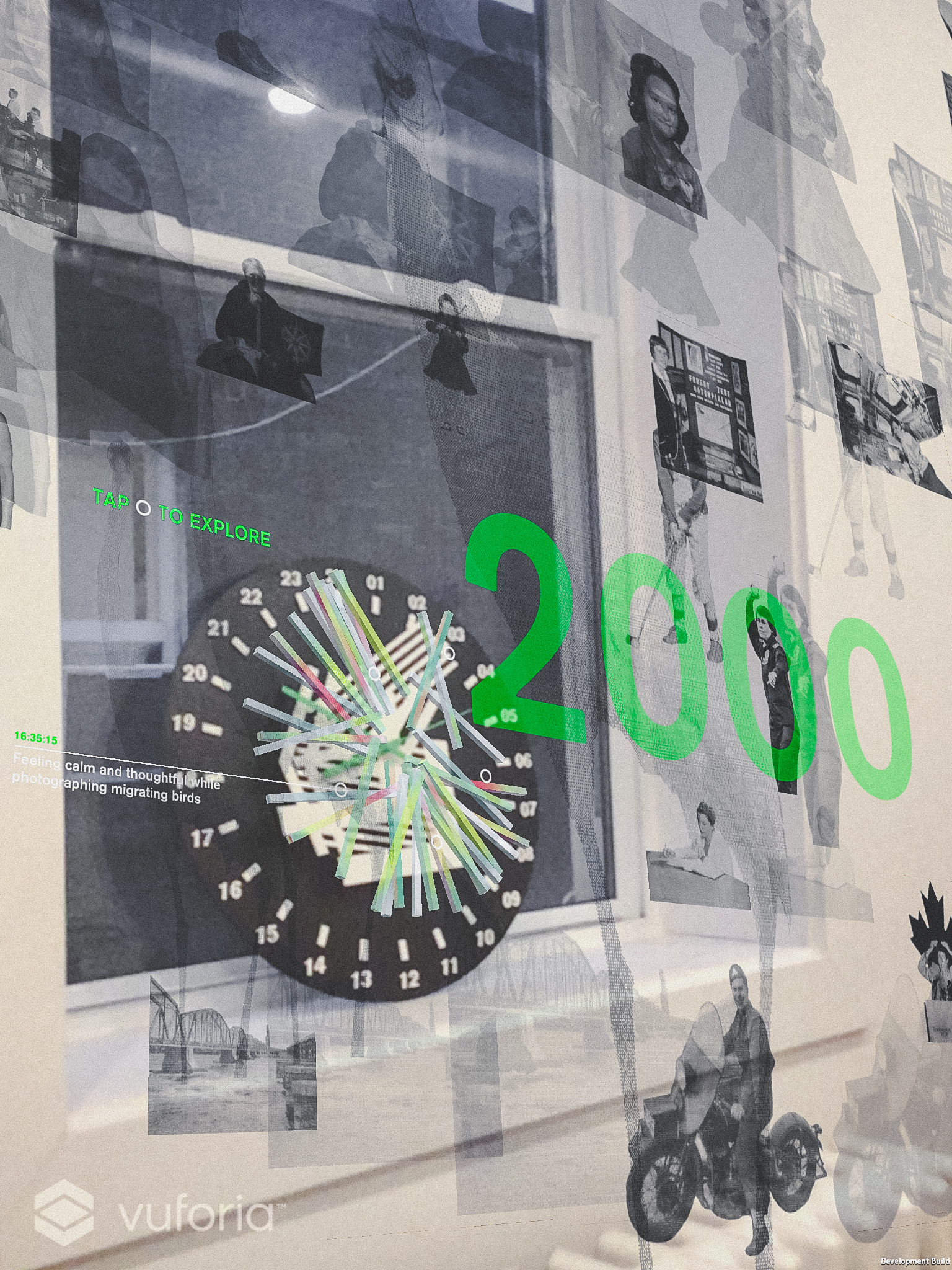



💭 Project Description
This object—a 24 hour clock—exists simultaneously in both physical and digital spaces. It is meant to create personal narratives using measured and perceived scales of time, visually connecting memories, information and data to be viewed as a compilation of one’s life. From seconds to years, years to decades, the clock is a tool to build individual and collective pasts, presents and futures.
This is a prototype. The realized version of the app experience allows a user to add sources for various content, developing different narrative threads interwoven across their life, and forming a multisensory, reflective experience of their personal journey. Narratives are viewed using augmented reality (AR) and can overlay different types of data and information such as schedules, health data, social media, etc to create comparative visualizations or relive forgotten pasts.
For the prototype, we needed a test subject to compile content and demonstrate what the experience of the clock would look like. We chose Roberta Bondar, best known as being the first Canadian female in space.
We used public images and interviews from Ms. Bondar’s life to create content for our prototype. We imagined a fictional day-in-the-life to showcase how one’s personal data, memories and life could be coordinated and connected to showcase experiences of self reflection and self awareness.
The project team included: Christopher Pandolfi, Melanie Kapogines, Raphaella Valeri, and Shaili Chibba.
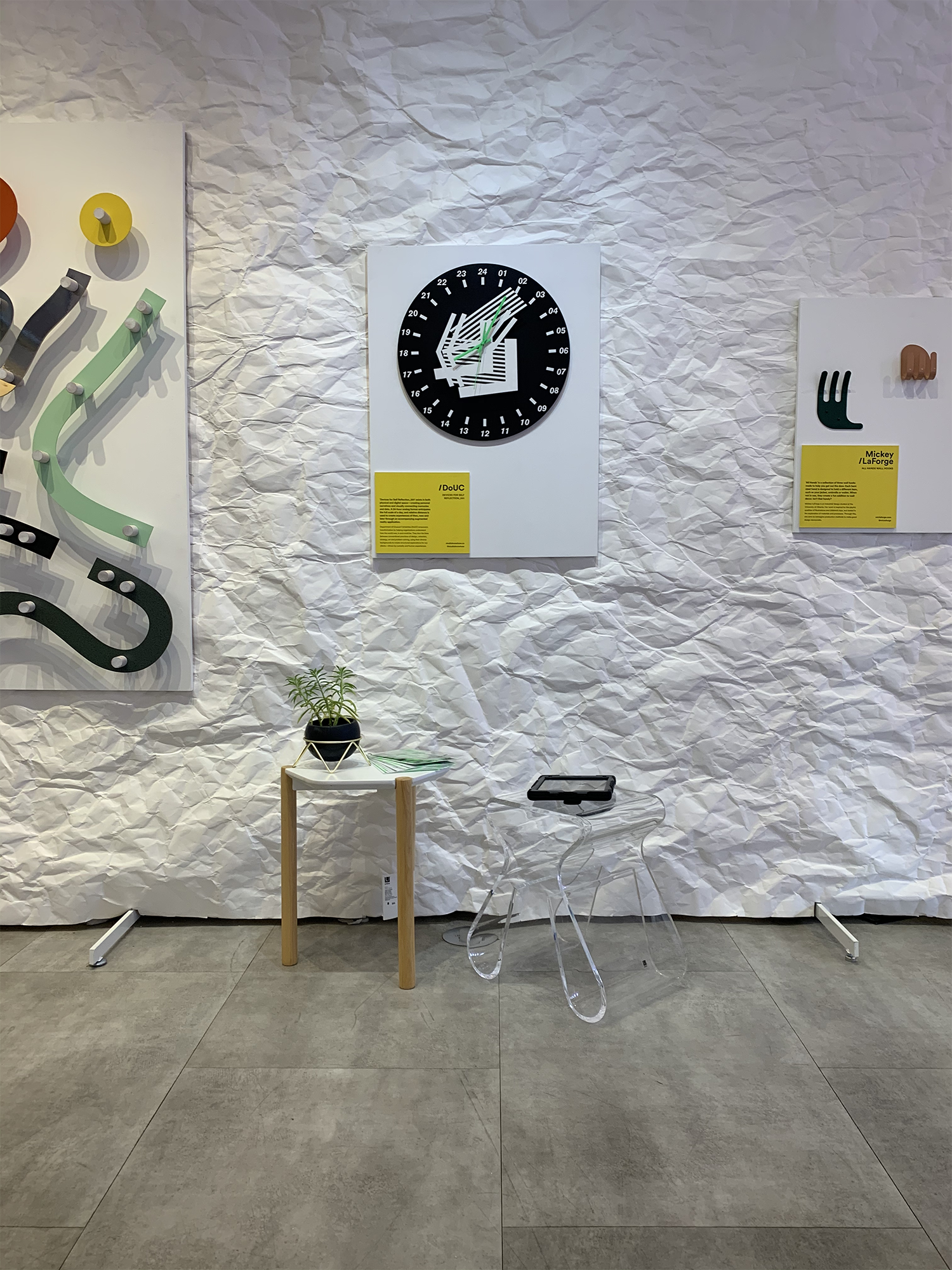
The final prototype setup at DesignTO’s 2020 Work/Life exhibition.
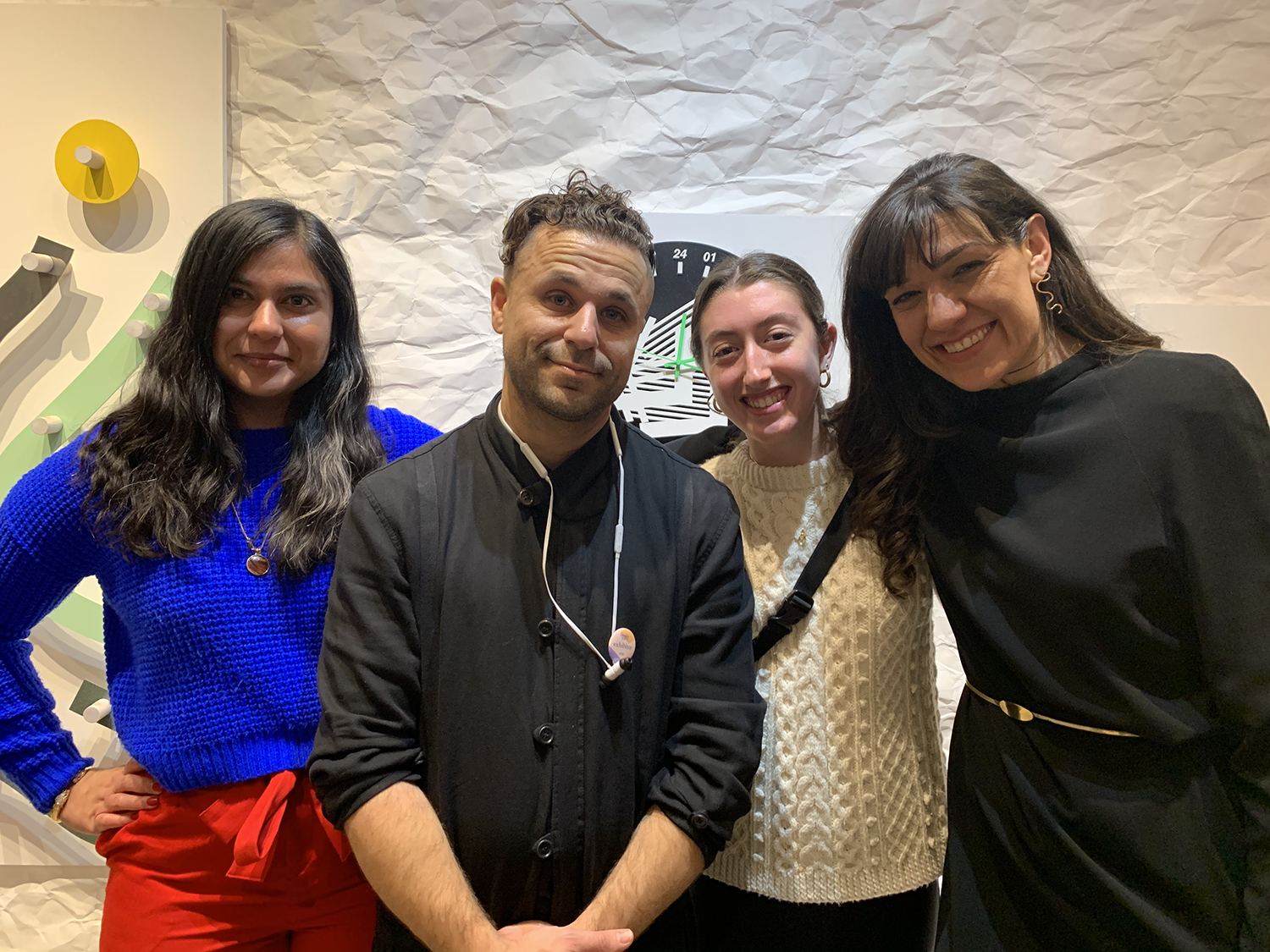
The team, from left to right: Shaili, Chris, Raphaella, and Mel.
To commemorate DoUC’s 10 year anniversary, we have organized an interview series highlighting past DoUC projects.
We wanted to take this milestone opportunity to revisit projects in a fun and reflective way, calling on the perspectives of both past and present DoUC team members. Shifting from objective and brief project descriptions, we revisited our work with a renewed intimacy. With more personality. We hope this series provides deeper insight and understanding to past projects. Or, is simply a fun read!
To help you navigate this series, we recommend first reading the project summary for context. Then, you can explore the interview dialogue. Enjoy! 🙃
ℹ️ The devices_for_self_reflection_001 interview was conducted with Chris Pandolfi (CP), Melanie Kapogines (MK), Raphaella Valeri (RV), and Shaili Chibba (SC).
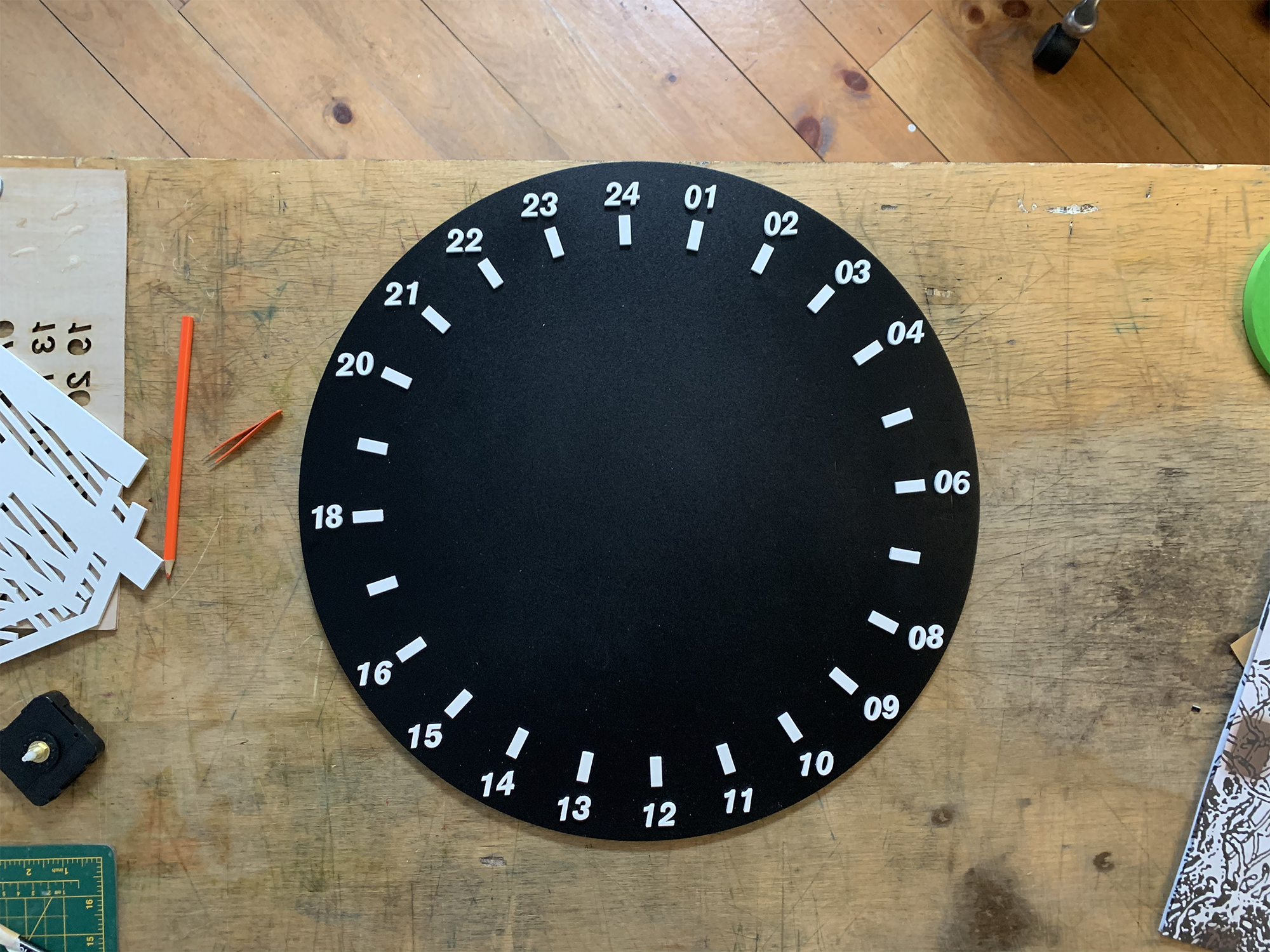
Mel mapped out the numbers perfectly by eye!
001 is a part of the Devices_for_Self_Reflection project series. As the first piece, why did you make a clock? Why does it display 24 hours?
CP ⤳ The clock is an interesting object. Its purpose is to show at a human scale the passing of existence. Time is a construct that many systems rely on. It orders things and like all things is based in power dynamics and inequality. Not everyone has the ability to control their time. Most people do not have the power to even determine how they truly want to spend it. The clock is the measure of all these constructs and what I found interesting about 24 hour clocks is that they show you that in a day the time that has truly passed. Meaning that when you look at the clock no matter what time of day it is you are getting the full story of the day. Where with a 12 hour clock it does not allow you to look at your day with this perspective. It forgets the time that has passed. A 24 hour clock allows you to reflect on where time goes because you see the full story.
RV ⤳ We use our clocks daily, multiple times a day, seven days a week. Clocks, as we all know, show us the time. We use them to help us stay on track, get places on time, wakeup on time, etc. — basically, they help us form our daily schedules. With our 24 hour AR clock (Devices_for_Self_Reflection_001), we wanted to create a device that encourages the user to reflect on, and visualize their day-to-day lives and past experiences in an interactive and fantastical way. Having the clock display 24 hours allows us to reflect on time and memories in different and new ways.
SC ⤳ Apparently Chris has been exploring the idea of a 24-hour clock for years! So, while we were finally reviving the idea/project, we realized that it actually fit perfectly within our City of Experiences series for City Objects. And, to be more specific, we have been actively exploring the idea of self-reflection at the studio, and got curious about how this clock and other objects could fit into it. One of the ways it does this is get us to be more aware of time, specifically our daily relationship to it. 24-hours really makes that 1-hour mental break seem small and inconsequential, whereas in a regular 12-hour clock it feels like a rather significant chunk of time.
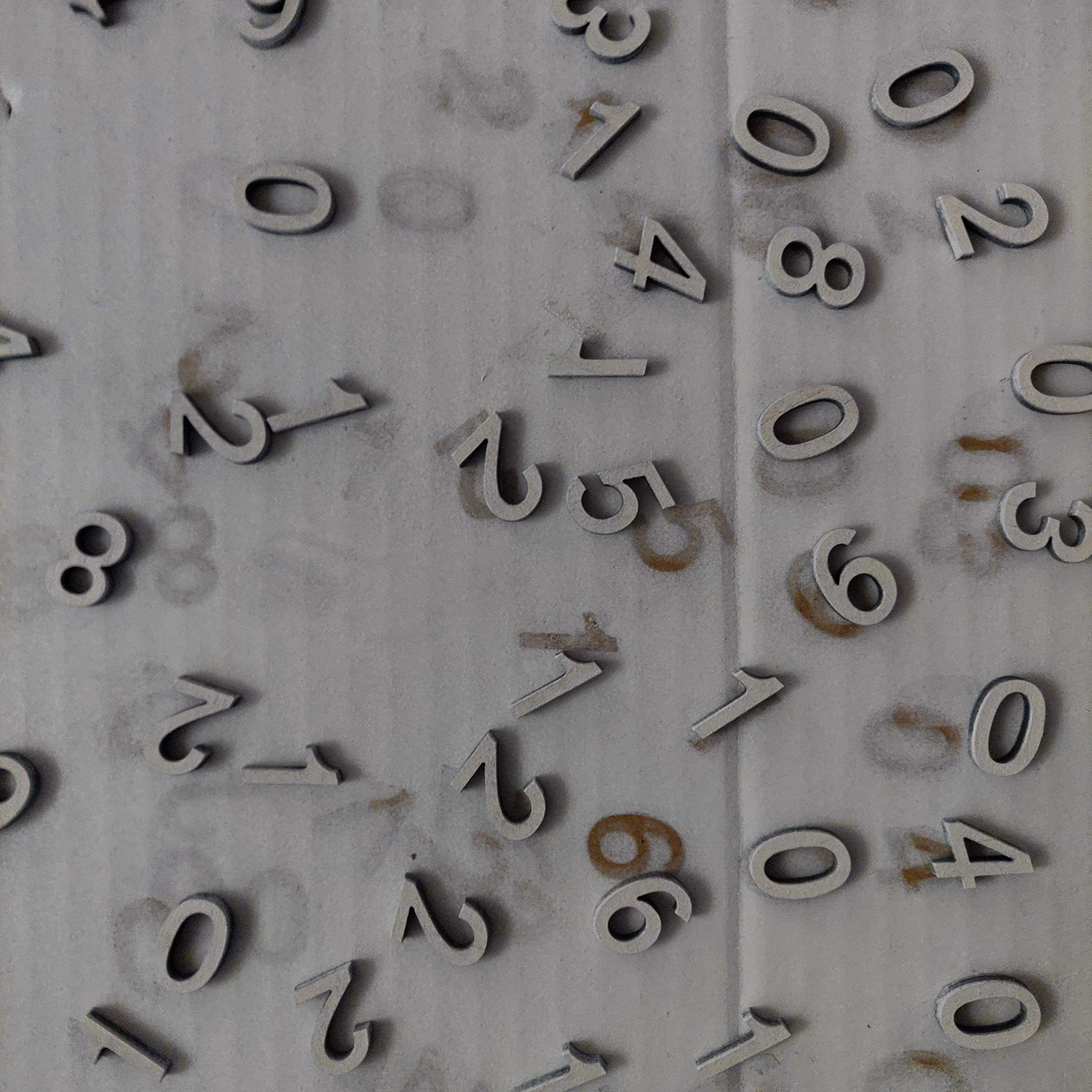
Spray painting numbers for the clock.
The clock was designed to perform functional tasks as well as inspire moments of self reflection. Can you tell us more about this idea?
SC ⤳ At the studio we’re constantly exploring the idea of self reflection, and it’s especially interesting for us to look at it personally to reflect on how we individually approach it, and more importantly, don’t. What I mean is, for all the times that the greater forces of capitalism get in the way to give us quick-solutions that are meant to keep us coming back for more. Like scrolling endlessly on Instagram, you feel me? So, as designers we kind of want to interrupt these moments and give you back some control to take the time to really examine your life and reflect… so that we can all grow and make better choices. Some would say that was corny af, but I think it’s ~wholesome~ 😀
CP ⤳ I think that if people can look at their day and see a picture of it in real time all at once at different moments it will allow them to actually reflect on the ways they spend time. The additional layers we add to the clock plays with the idea of scales and time. In that, if the clock allows me to see my day, then the obvious next jump is imagine if all my days being recorded by the clock, allowing me to then look at my entire life. The clock transforms from an object of function to an object of imagination.
RV ⤳ In addition to telling time, our clock includes AR functions that allow the user to visualize their day, and past memories (using images, sounds, and video footage) — encouraging moments of self reflection on one’s past, present and future self.
“Many of these projects help us take our interests and internal research we are doing and then figure out ways for us to learn new skills, work in different ways and eventually create processes and methods that we bring into our client work.“
Why is it important for the studio to execute projects such as this?
MK ⤳ We need to keep stretching our brains. Client work can be great but it’s usually about getting a specific result and has boundaries. Making time to do things for ourselves, to push ideas just for the sake of exploring them, to still do some weird projects that we’re not being paid (properly) for…I’d like to think it helps with creativity and always staying a bit ahead in our thinking. These projects also almost always turn into something else down the road or pieces of the ideas are incorporated into other projects, so they’re valuable that way too. Plus it’s usually just a lot of fun 🙂
RV ⤳ Our AR clock (Devices_for_Self_Reflection_001) is important as it encourages regular and routine moments of reflection which is something we see a great deal of value in.
CP ⤳ The idea of self reflection or in other cases collective reflection is something that I feel it is a driving force for our existence as a studio. It allows us to explore in different ways people’s existence and the systems that drive that existence. Many of these projects help us take our interests and internal research we are doing and then figure out ways for us to learn new skills, work in different ways and eventually create processes and methods that we bring into our client work.
SC ⤳ I think it’s super important to keep exploring and experimenting to push ourselves critically and creatively. Plus, this naturally comes back to make our client work even better 🙂

Mel testing out all the positions of key elements on the clock.
How did the City of Experiences project repertoire influence the planning and design processes of the clock?
CP ⤳ Hmmm…I think it’s hard to nail one thing. It’s more how many projects influence this work. For example our constant need to make timelines and maps to help understand the kind of 5w’s of how systems operate. The learnings we have from our community engagements and how people make decisions on how they live their daily lives. I think the clock takes its influence from our overall learnings at DoUc and not necessarily one project. Maybe to be more specific in regards to the City of Experiences, is this idea that our world has evolved and the the products systems and services we create are also evolving in how we can find deeper meaning, not my algorithms that construct our existence based on our habits, but instead tools that help us reflect on why they have our habits. This to me is the most important thing you can do. Allow people the opportunity to learn and grow about themselves and their communities.
SC ⤳ It didn’t quite influence it as much as it naturally integrated into it. The only specific way it came to be a part of the design process in the clock was through the integration of the emotion gradient from the bike really.
RV ⤳ Our City of Experiences project repertoire provided us with a general framework for developing our AR clock — not in a literal sense, however, more as a way of thinking. Included in our City of Experience repertoire our technology-based city objects (e.g. the AR Clock, an AR Art Bike, as well as others).
MK ⤳ It’s again this idea of having new experiences layered on top of everyday objects, keeping the original use intact and giving the user the option to opt-in for the bonus features to get a richer experience. After finishing the bike last year, the clock was a perfect chance to keep going with this thinking and showcase it at DesignTO.
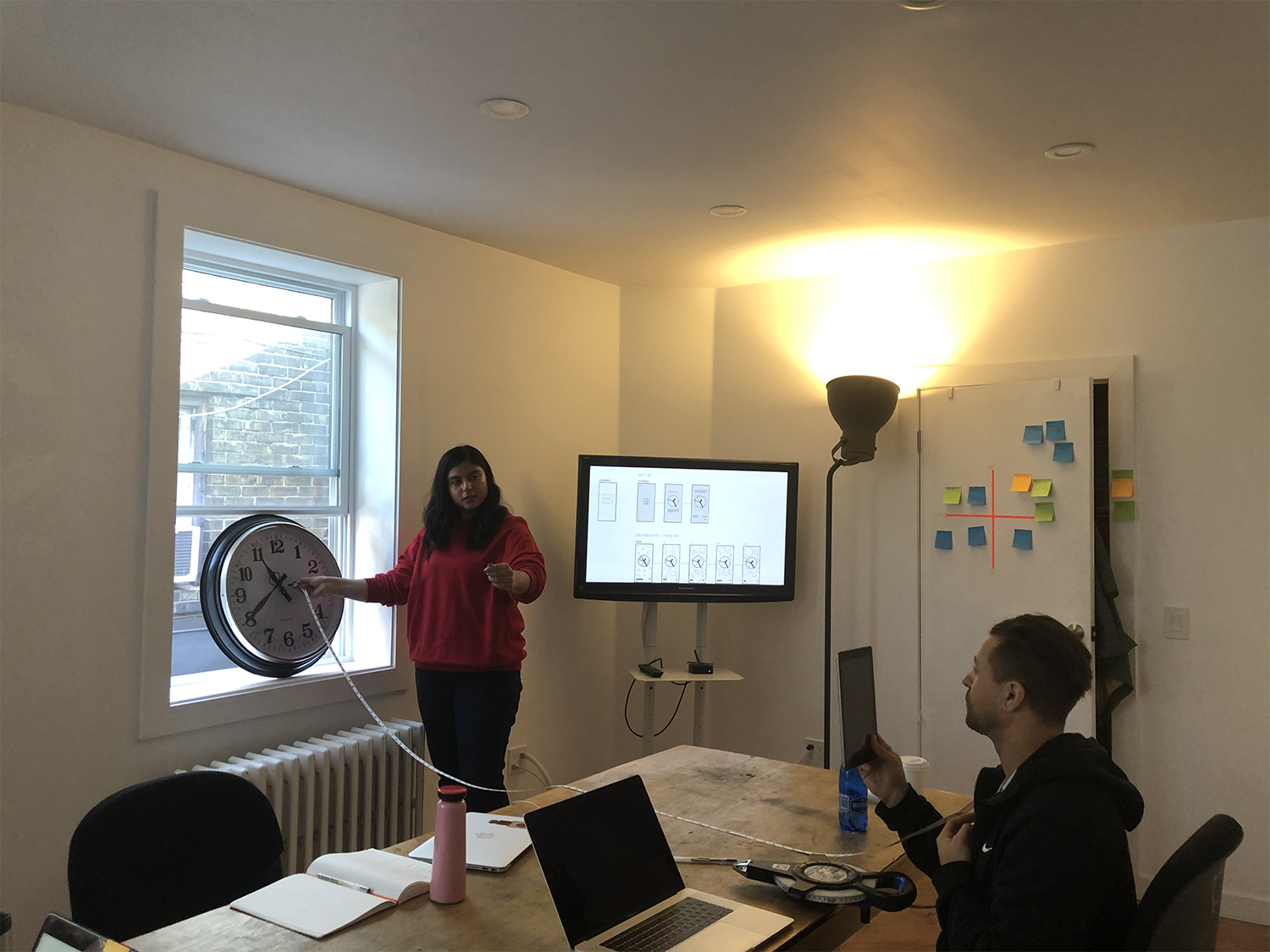
A little bit of distance research for the AR scale in the studio.
What was the research process like for this project?
CP ⤳ Amazing…We created paper prototypes, diagrammed systems, explored different technologies and went deep into the stages of selfrflection>>>self awareness>>>self action. allowing us to understand what we were truly trying to create. It also involved all members of the studio in one way or another. It was a true DoUC project – all our perspectives and all our skills and built through a process that was started before the project.
SC ⤳ We didn’t do much outside research, and treated it more as a personal project— asking ourselves as many questions as possible on our own experiences with time and reflection.
RV ⤳ We explored theories of self reflection and design-based research involving interesting ways to use and display AR. We also did a lot of prototyping in our studio to help us develop the physical aspects of our clock.
What inspired the idea to add AR functions to an “everyday” object? Why AR?
SC ⤳ I think that this comes through our CoE explorations, which are meant to create enhanced experiences, and we think that AR is going to be a big part of the world very soon. So, we really want to see how it can be used to create more human-centric experiences that are rich with meaning and engagement.
RV ⤳ AR is very interactive and can visually display information in what appears to be a dimensional way. AR can also showcase video and sound which adds an interesting layer of interaction. Adding AR to daily objects, like previously mentioned, encourages moments of self reflection as it allows the user to be more involved in the experience.
CP ⤳ I think for me it’s never about what technology to use, but understanding why it is used. What I enjoy about AR for projects like this is really simple. We are able to make these hidden layers or additional layers of projects like these visible and work simultaneously with the physical objects and spaces. The AR layer allowed us to create an alternative space of exploration. One that could appear anywhere. As long as you had room for the clock, the imagined world could become visible and adapt to almost any space.
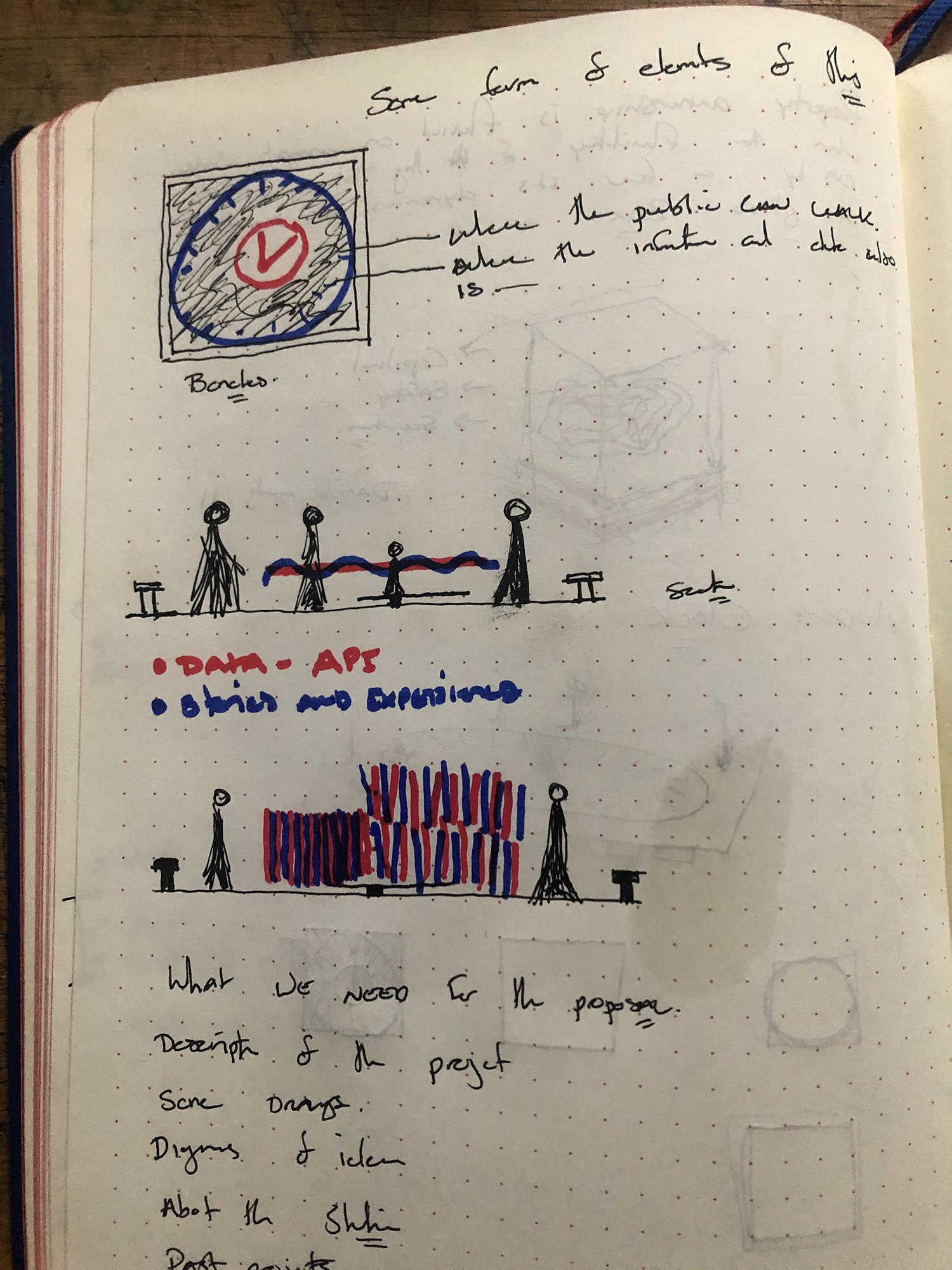
A little peek inside Chris’s sketchbook. Some early ideas and handwriting up for deciphering.
Tell us more about the design process for this project! What went into designing the physical clock prototype? What went into designing the AR functions? How did the two aspects influence each other?
MK ⤳ There were a lot of ups and downs lol. It’s hard for these projects where we’re being paid nothing to balance costs with quality, making sure we’re putting something awesome out into the world without bankrupting the studio. In the end the clock came out beautifully, and it evolved as we went….material and colour changes, great ideas for how to present the AR content. Last minute crises with laser cutting, friends bailing us out, spray paint drama right before Christmas. The challenges are what makes it fun and interesting, if we just planned everything out and executed in a straight line we wouldn’t learn anything, wouldn’t get any better.
SC ⤳ Chris and Mel handled the prototype beautifully and I think their answers will have some nice tidbits on that end. As for the AR functions— the design was done on Unity. Chris worked on the visuals while I worked on putting everything together in 3D space and activating the interactions. Getting that look and feel right in a spatial sense was a bit of a challenge. I wasn’t quite sure what would be chaotic, or what would just be a boring collage, and finding that happy medium took a bit of finessing.
RV ⤳ To help design both the physical clock and AR functions we prototyped a lot in our studio by playing with size (mainly for the face of the clock), playing with distance (specifically the distance of the user from the face of the clock), playing with shapes (how we wanted the AR functions to be displayed), and visual materials such as photographs and images.
“Humans are terrible historians of their own lives. We forget almost everything, and edit and revise what’s left without really being conscious of it.“
In the description from the app, the experience “is meant to create personal narratives using measured and perceived scales of time, visually connecting memories, information and data to be viewed as a compilation of one’s life. From seconds to years, years to decades, the clock is a tool to build individual and collective pasts, presents and futures.”— in your opinion, why was it important to use these factors to build a personal narrative? What kind of memories, information, and data would be used to build the narrative?
MK ⤳ Humans are terrible historians of their own lives. We forget almost everything, and edit and revise what’s left without really being conscious of it. Having something to help us revisit past moments that’s built on real information, but isn’t necessarily presented in a chronological fashion, could be an interesting way for us to reflect on our lives, be reminded of the reality vs what we’ve constructed in our memories, and make new connections between moments, feelings or thoughts we may have missed when thinking about them in the order they happened.
The obvious thing to include is images and other concrete information that is already shared externally, but it would be really interesting to passively track other data, like moods, that we’re conscious of in the moment and then almost immediately forget. You might start to see patterns that are normally lost because we can’t store all the bits of passing data about ourselves in our heads for much more than a hot minute.
RV ⤳ Memories, information and data a user can collect to help build their personal narrative include; images, video footage, audio recordings, health data, personal schedules (e.g. appointments, meetings, or dates), contacts, etc. The clock organizes and saves the users data so they can reflect on their life and experiences as time passes.
CP ⤳ Hmmm…I think this would be up to the user. I think being cautious here that memories can be triggers and always ensuring that the user would have control to include things that they decided. I think we thought about this, but as we could continue to develop the prototype making these constructions in the clock possible would be something that would need further explanation. I think in terms of the data and information – it is something similar that I has said in the Inuit art project. That it allows for full a picture, a better story with more context. The details and the conceptual. In a simple way it provides a more interesting and more honest view.
SC ⤳ Any old clock tells you the time, programmable clocks let you set alarms and timers for specific tasks— our clock allows you to see your daily life in context to various scales. To start you get to see your 24hours as planned out by you, so you’re getting the scope of your entire day and how you choose to spend it. This allows you to start asking questions like, “is this all that I need to do today?” or “is this how I want to spend my time today?” etc. Then, around each of these tasks we have created a kind of memory-space. This area, we imagine, will connect to your albums, your feeds, and your other sensors to “collage” associated past-information around a specific scheduled point. So, if you’ve scheduled an hour long walk in the park, the memory-space will show you visuals, from previous walks you’ve taken and anything you’ve collected from them. It’s an opportunity to see where you were and where you’ve come.
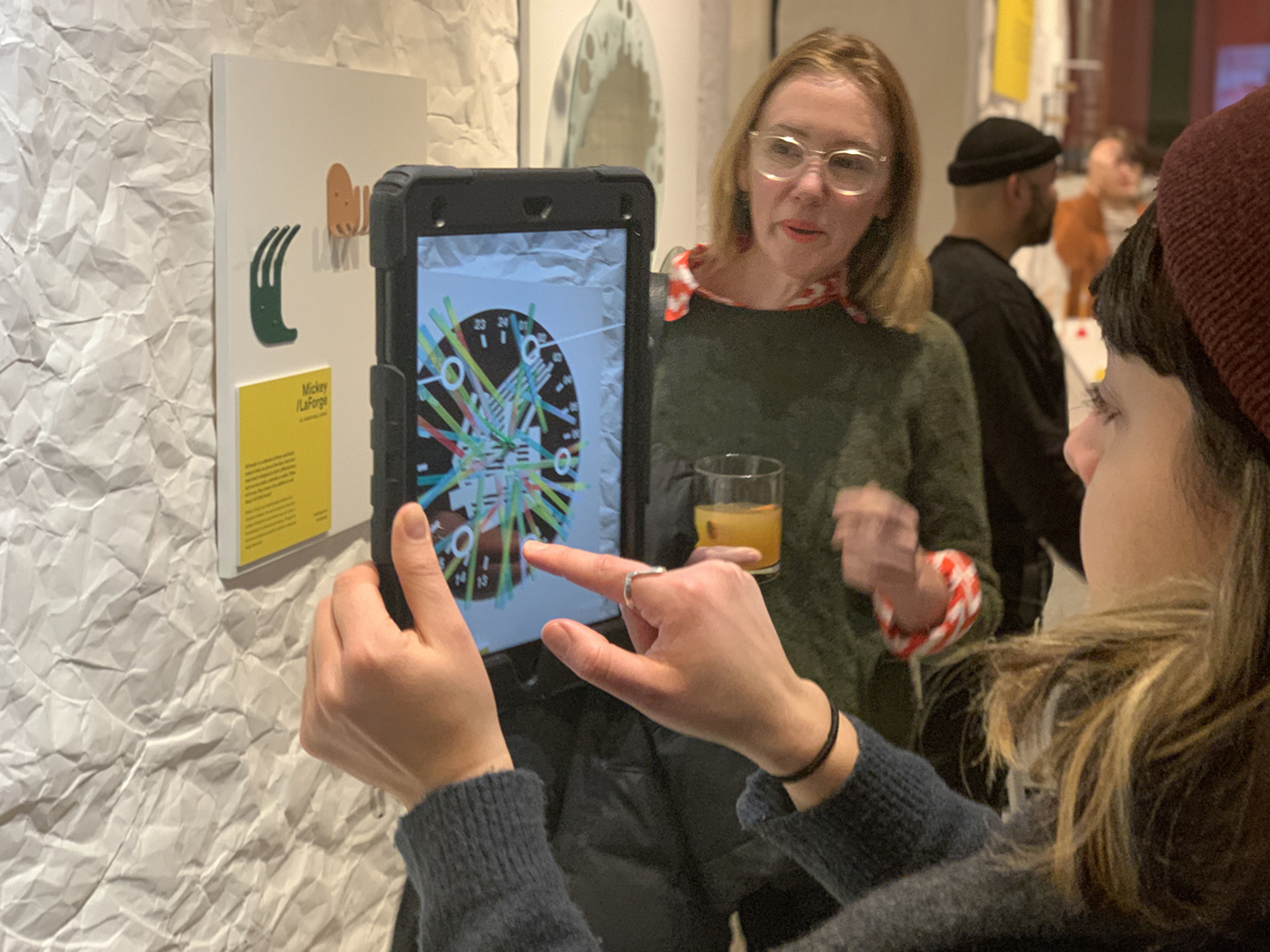
A guest testing out the experience during DesignTO’s 2020 Work/Life exhibition.
From the photos, it looks like you used “sticks” that display a gradient of data— why did you choose to visualize in this way?
CP ⤳ The “data sticks” were an attempt to map the data based on the time of day they happened but also being respectful that the time of day would be over multiple days, weeks, months, years, etc…It would allow the user to look at their different point in one place at a specific hour in time and allow them to find their own meaning. The physical clock becomes the grounding of the data and the AR layer allows for a more interesting approach to the actual visualization.
SC ⤳ At the end of the day, once you’ve gone through your tasks, you’ll see a series of bars come to be stacked on your clock. These will add a layer of emotion-based data to enrich your reflection. Again based on a scale from joy to fear (like the bike), we want to use similar sensors to give us the range. Together, you get to look at your life through the lens of each individual aspect of the experience and find interesting intersections to dig deeper.
What is the significance of the colours used in the gradient?
CP ⤳ LOL, See NSA custom gradients created by DoUC that we use in many of our projects. I think this needs another interview or at least a project profile on the archive.
SC ⤳ They are the same as the ones selected for the bike, green for joy and red for fear. I think I explained it in that interview as those colours having a fairly fundamental relationship to human psychology— green = nature and life, red = blood/danger. So, it was a simple and clear association really.
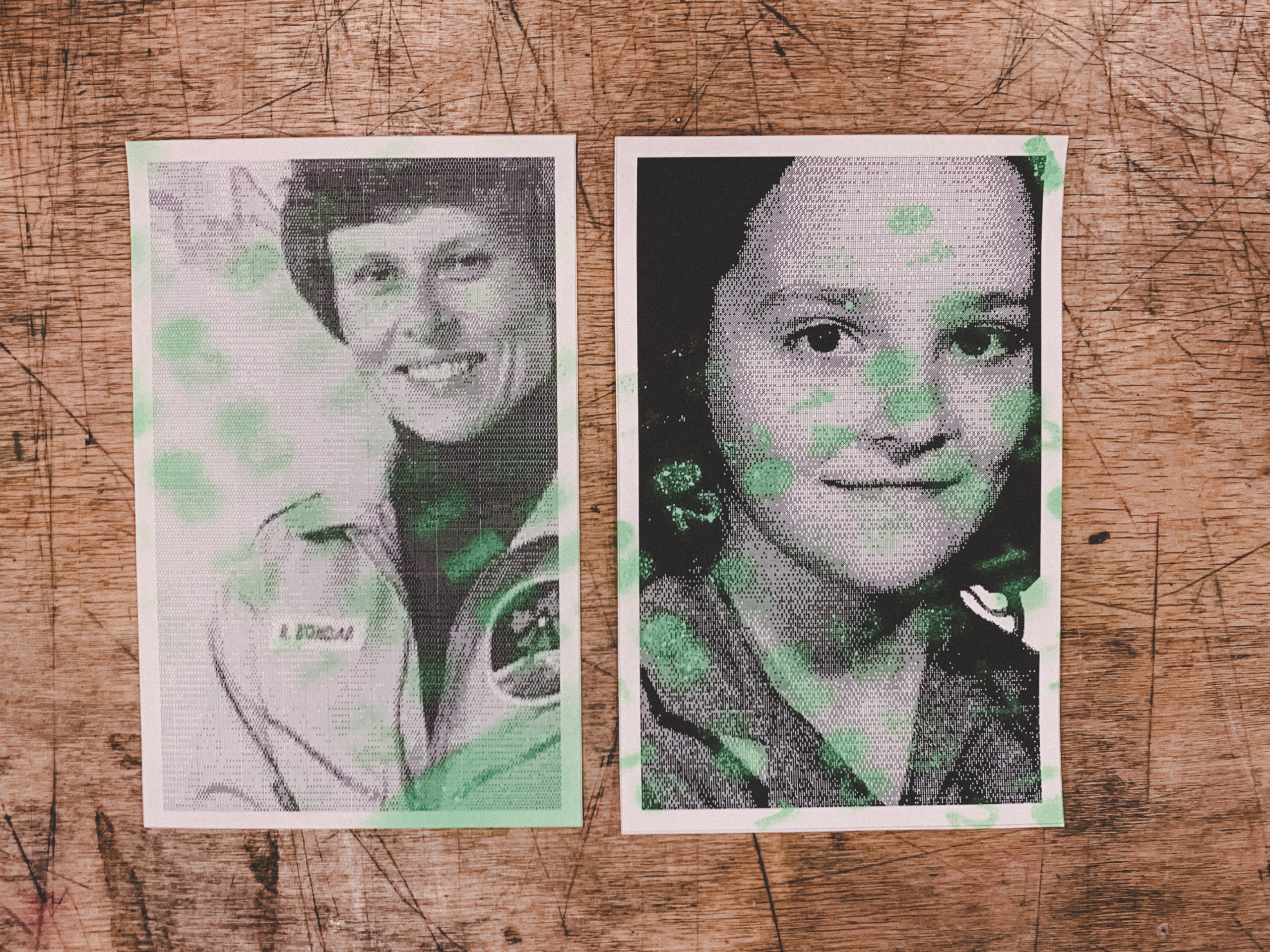
First Canadian female astronaut in space, and all-around super cool human Roberta Bondar— the basis for our prototype experience!
There also seems to be a collage of visual media around the clock from various years, attempting to capture memories relevant to a timed task. Why have you chosen to show them in this way?
SC ⤳ We really didn’t want to just collage them just around each scheduled task, so we actually created a bit of a spatial experience. You can walk around your memories almost like a little museum and think about your life.
CP ⤳ I think what the collage of memories does is that it breaks up the linear thinking of time and show things not just as pieces but moments of the larger construction fo your life. A mixture of experiences make a life and how we interpret them is never so clear. The collage creates a visual representation of this thought.
RV ⤳ Collaging visual data such as images and video footage creates clusters of memories for the user to reflect on in the future. These clusters include multiple data types (possibly images, videos, audio records, or written information) that create a well rounded source of information for the user to look back on.
“I would really enjoy having this clock for daily use as a way to reflect on my memories, organize my time, and create personal goals for my future. I think having so much information and data dispersed and stored on different devices makes me forgetful of important personal memories. “
How do you picture this clock used in your daily life? If you owned this clock, what would it be used for and how would you interact with it?
CP ⤳ LOL, if I owned the clock it would be exactly how we designed it ;). But I would hope that people would every once in awhile look at just the clock and wonder why they spent the time the way they did and just think about that. I also like the idea of what we often think as banal memories can become more interesting when revisit them at different points in our life.
MK ⤳ I think the ‘present time’ functions and content could be used simply as an organization tool, but the real goal is for it to prompt small moments of self-reflection in between the rest of your day. It isn’t meant to be a therapy session, it’s meant to give little ‘huh’ moments. I imagine I’d use it to slow myself down, almost like how you pause and glance at yourself in a mirror on your way out the door. But instead of realizing I have something stuck in my teeth, it might let me start to see more about why I am who I am or to appreciate the small things that make up a life but get forgotten.
RV ⤳ I would really enjoy having this clock for daily use as a way to reflect on my memories, organize my time, and create personal goals for my future. I think having so much information and data dispersed and stored on different devices makes me forgetful of important personal memories. Having this data organized and displayed in the clock would allow me to reflect on these memories more regularly — something I would very much enjoy.
SC ⤳ I think it’d be incredible if this clock was everywhere and we looked at time and how we spent it a bit differently. I would personally love it if something showed me my memories in context like this right away, because I’m sure there’s so many things that I forget to think about as I get caught up in the day-to-day and would love to see what lessons they could offer.

A diagram detailing the layers of the experience.
Why do you believe self reflection is so important and necessary?
MK ⤳ We’re generally a pretty terrible, broken species and have very little formal education in how to understand ourselves. Society seems to only push us to reflect after a crisis, personal or otherwise, and we’d all be a lot better off if we learned how to look inwards on a regular basis instead of just during adversity.
CP ⤳ In a world that has become increasingly about delivering full experiences in where the user has limited choice. Self reflection specifically in the design of digital projects allows users to have more choice and freedom and more importantly demand more choice and freedom. Self reflection is hard to do and finding time for it is even harder. I think one of the many roles for the designer is to ensure we are doing both.
SC ⤳ It’s essential for self-growth. Specifically, positive self-growth. I don’t think I would ever make any significant changes in my life if I was constantly reacting to things, reflecting helps me anticipate and change course to do something new. So really, it makes life a lot less boring in a way!
RV ⤳ Yes, 100% I do. Self reflection allows us to identify our values, interests, strengths, weaknesses, and enjoyments which can have a very positive impact on oneself and one’s relationships with others.
What do you hope for the future of this project?
SC ⤳ It would be fantastic to really integrate all the pieces so that we could experience this live. I would love to have this in my own home!
RV ⤳ I hope others can use our clock and it could be a product people use in their day to day lives.
MK ⤳ I still want to see it in an airport (remember those?), with different content and interactions. Airports are strange environments where everyone is transient, usually in varying levels of zombie-states, often bored and killing time between flights. It seems like the perfect detached-from-reality place for people to pause and have a reflective experience, or even just a weird educational experience interacting with the AR.CP ⤳ I want to develop the next iteration of the prototype, but truly i want everyone to have a clock like this in their homes.
